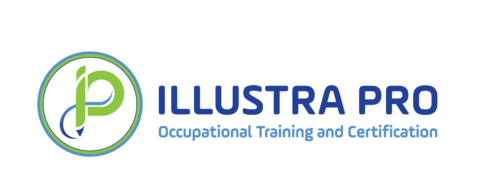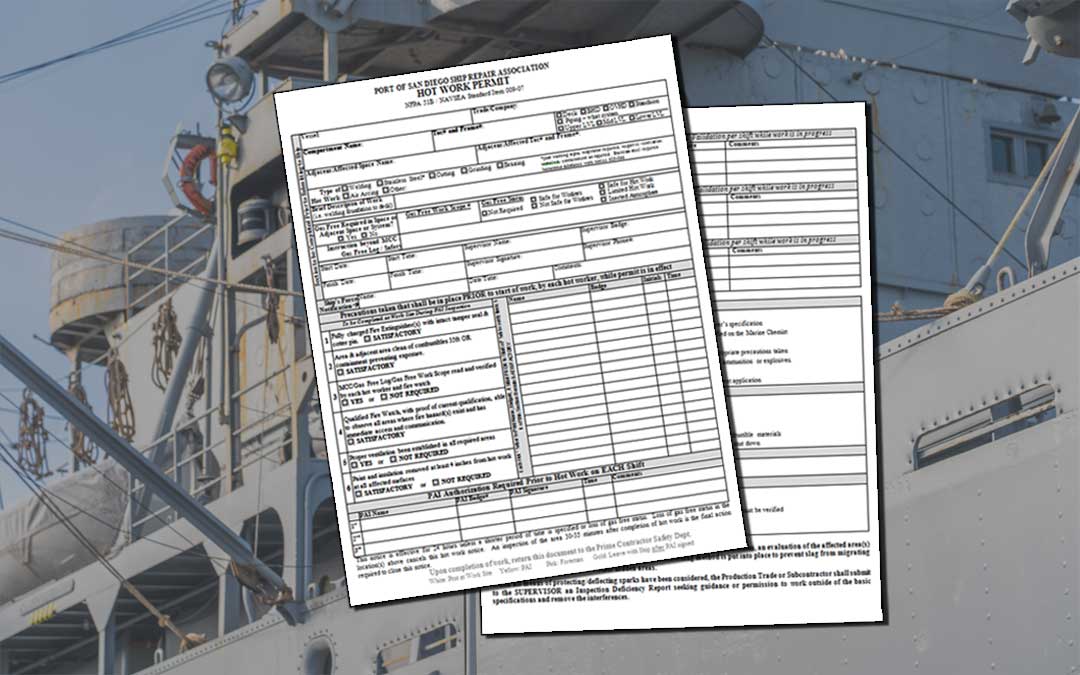In the maritime industry, hot work activities like welding, cutting, burning, abrasive blasting, and other heat-producing operations are essential but come with significant safety risks. Due to the flammable materials and confined spaces commonly found on ships, hot work has a higher risk of sparking fires than in many other environments. This is why strict adherence to the maritime hot work permit requirement is essential to safeguard both crew members and assets.
Hot work permits are safety documents that confirm proper adherence to precautions before any hot work begins. Completing the requirements for this permit requires expertise, including understanding maritime safety regulations for hot work and following a detailed checklist as part of the hot work permit process in the maritime industry.
The Permit Authorizing Individual (PAI) has an important role in this process. This individual is an assigned competent person that ensures that all necessary safety protocols are observed in the area before and during hot work to ensure it is free from fire hazards. Illustra Pro’s PAI course equips safety professionals with the skills needed to manage hot work safely and in full regulatory compliance.
What is Hot Work in the Maritime Industry?
Hot work, defined by NAVSEA is any shipboard operations that generates sparks, flames, or heat in sufficient quantity to cause the ignition of flammable materials. Common maritime hot work activities include welding, torch cutting, and metal grinding, and the activities are often completed inside confined spaces where poorly ventilated areas such as ship holds, tanks, piping systems, and/or small compartments.
Due to the unique hazards of the maritime environment, each hot work operation must be carefully controlled under strict supervision, adhering to vessel hot work safety guidelines and backed by proper marine hot work risk assessment.
Illustra’s training focuses on training personnel to manage the safety protocols surrounding these activities. This includes training for Permit Authorizing Individuals (PAIs) and fire watch personnel who are essential to hot work safety.
Why Hot Work Permits Are Essential for Maritime Safety
Hot work permits are one of the most important precautions in maritime, where hot work shall only be carried out in controlled environments. Because of the unique hazards onboard military vessels, the permit system will have a checklist for several precautions to be checked and signed off before starting any hot work: notices to the ship personnel, conducting inspections, arranging a fire watch, removing flammable materials from the work site, and checking ventilation. These permits help reduce the chance of fire and ensure safety at each step.
Following a hot work permit checklist will prevent accidents and could even save lives. The PAI signs off to confirm that compliance for maritime hot work permits is upheld at each step of the process.
Hot Work Permit Process in Maritime Industry
The hot work permit process in the maritime industry consists of multiple steps.
- First, in maritime settings, the Permit Authorizing Individual (PAI), or competent person in charge of hot work permitting, authorizes the issuance and typically ensures compliance with hot work permits.
- Next, the maritime hot work permit must be submitted to either a fire marshal or the ship’s Commanding Officer. Once the hot work permit has been received, the permit is then required to be posted outside the work area in a conspicuous space.
- While hot work is being performed the fire watch needs to monitor activities, and if there is a change in conditions, halt the hot work and notify the PAI and/or ship’s Commanding Officer. (This may require a new maritime hot work permit or a written waiver approval.)
- After all hot work is completed, the supervisor is notified, and the fire watch must remain in the area least 30 minutes after the activity is completed.
The Role of the Permit Authorizing Individual (PAI) in Hot Work Compliance
The PAI plays a critical role in maritime hot work compliance by assessing risks, issuing permits, and monitoring hot work activities from start to finish. With safety legislation in constant development, training for PAIs is a regular affair to bring them abreast of current best practices. Illustra Pro’s specialized courses for maritime safety personnel prepare them to proactively manage risks and meet regulatory requirements.
Training covers everything from pre-authorization, where the PAI would review worksite conditions and identify hazards, to overseeing hot work to ensure enforcement of safety measures, through to post-work inspections to confirm the area is secure and fire hazards mitigated. Check out Illustra Pro’s list of training courses for the distinctive safety needs of the maritime industry.
Maritime Hot Work Permit Requirements
In addition to the details about the hot work operation, the Maritime Hot Work Permit Requirement includes a checklist that may or may not apply to every hot work permit. Items on the checklist may include:
Before Issuing the Permit:
1. Check for Explosive Atmospheres:
- A Shipyard Competent Person must evaluate the space for oxygen, flammability, and toxicity using a monitor.
- Hot work permit must Include the date, time, equipment details, and any unique conditions for the job.
- Ensure continuous monitoring of the air quality to detect any changes during the work.
2. Identify and Manage Nearby Combustibles:
- Remove combustible materials within 35 feet of the hot work area radius.
- If moving isn’t possible, cover combustibles with approved flammable retardant covers or guards.
3. Inspect Fire Protection Equipment:
- Verify that fire protection systems (e.g., sprinklers) are fully operational.
- Do not permit hot work in areas with impaired fire protection systems.
4. Ensure Surrounding Areas Are Safe:
- Assess adjacent operations for potential hazards that may affect the hot work area.
- Cover or block any openings, ductwork, or floor gratings that could allow sparks to escape to other areas.
5. Notify All Affected Personnel:
- Inform nearby workers, supervisors, contractors, and operators of the hot work operation.
- Post a notice or sign to alert others to the hot work and associated hazards.
6. Establish a Fire Watch:
- Assign a trained fire watch to monitor the work area during and after the hot work.
- Ensure they are equipped with appropriate firefighting equipment and understand emergency procedures.
During and After Hot Work:
7. Record Details on the Permit:
- Record all activity related to the hot work permit checklist.
Retain the permit on file for 3 years after the hot work operation is complete.
8. Issue a New Permit if Conditions Change:
- If a change in safety conditions arise, new hot work equipment is used, additional crafts are involved, or worksite conditions change, issue a new permit or receive a written waiver approval to account for the updated circumstances.
Final Thoughts
Maritime hot work onboard needs to be carried out very carefully as the fire risk is greater compared to other industries, and appropriate precautions should be taken. The maritime hot work permit requirement can be very comprehensive, and with the aid of trained personnel, like a Permit Authorizing Individual (PAI), the industry should be in a position to cope with the risks. Illustra Pro’s specialized maritime training courses provide the required knowledge to ensure hot work safety and maintain regulatory compliance for the well-being of crew and vessels.

